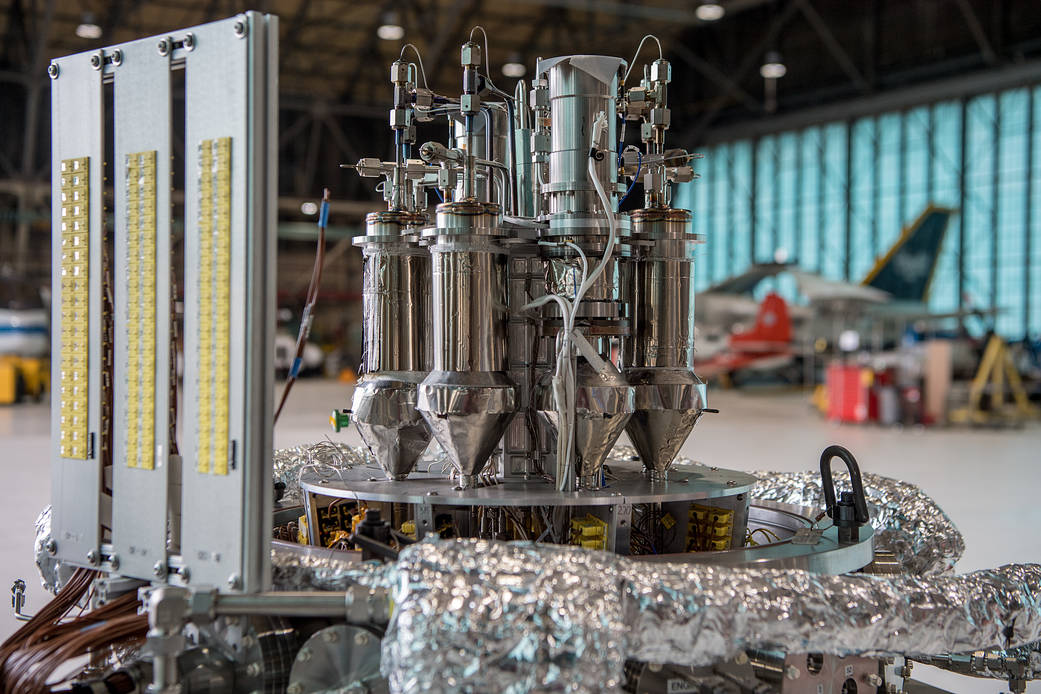Kilopower Project: NASA Pushes Nuclear Power for Deep-Space Missions
Many of our most ambitious space missions to space have been made possible using nuclear power. On Thursday (Jan. 18), scientists and officials from NASA and the Department of Energy gathered at the National Atomic Testing Museum in Las Vegas to discuss the Kilopower project, the next generation of nuclear power plants for future space missions.
In the past, NASA has used radioisotope thermoelectric generators (RTGs) to power spacecraft like Voyagers 1 and 2, the Apollo Lunar Surface Experiments Packages, and the Curiosity rover. This device directly converts heat from decaying plutonium into electricity. It has no moving parts, making it ideal for applications in space. However, it is not terribly efficient. Nuclear reactors can take advantage of active nuclear fission, or atom splitting, to be far more efficient, and NASA has been researching this technology for decades.
The United States flew its first space reactor, SNAP-10A, in 1965. However, from the late 1970s through the early 2000s, space reactor development has been largely unsuccessful. "There hasn't been any tangible progress in fission reactor technology in decades," Dave Poston, chief reactor designer at Los Alamos National Laboratory in New Mexico, said during the conference. [Nuclear Generators Power NASA Deep Space Probes (Infographic)]
The complex fission-based projects required lots of research and development. "They tended to run very long, they were decades in length, [and] the costs ran up from hundreds of millions to billions of dollars," said Steve Jurczyk, associate administrator of NASA's Space Technology Mission Directorate. "And in the end, they invariably were canceled."
Unlike previous technologies, the Kilopower reactor is simple, inexpensive and relies on fuels and technologies that are already well understood, NASA officials said. It uses active nuclear fission, like a conventional nuclear reactor, which will enable it to harvest far more energy from its uranium alloy core than an RTG could. A heat pipe clamped around the reactor core will transfer heat to the unit's power generators: small Stirling engines, a technology that was developed in 1816. The engines are simple pistons that convert heat into motion, which is then converted to electricity. The reactor will radiate excess heat from an umbrella-like cooling array.

In 2012, Los Alamos National Laboratory and NASA's Glenn Research Center in Ohio conducted a successful proof-of-concept test of the reactor, and NASA gave them the go-ahead to continue development and testing at the Nevada National Security Site. Right now, the team is conducting component testing to determine the reactivity-worth of each of the reactor's parts, namely how they react to the neutron radiation generated by the fission reaction. This phase of testing should be completed this week, according to officials at the conference. Then the project will progress to cold-critical testing, which will test the reactor's components, this time with the enriched uranium fuel core inside, officials said at the conference. Full power testing is scheduled to begin in mid-March.
Get the Space.com Newsletter
Breaking space news, the latest updates on rocket launches, skywatching events and more!
NASA's interest in sending astronauts to Mars has provided the primary impetus behind the Kilopower project: The power demands for a human mission to Mars will be far greater than the requirements for previous robotic missions, said Lee Mason, NASA's principal technologist for power and energy storage. "The Spirit and Opportunity rovers, the Phoenix lander, the Curiosity rover: all the power systems on those missions were less than 200 watts," Mason said. "A human mission to Mars is likely to require on the order of 40 or 50 kilowatts [40,000 to 50,000 watts]."
NASA is considering power sources like solar arrays, Mason said, but a number of factors make nuclear power a more attractive option. For one, the surface of Mars receives about one-third as much sunlight as Earth, and frequently sees dust storms that reduce this even further. Additionally, reactors are smaller and lighter than a comparable system of solar arrays and batteries, Mason said.
The reactors have a variety of applications besides human missions to Mars. They can power orbiters and landers, providing them with far more electricity than their predecessors. The reactors can also power electronic propulsion systems. NASA is also particularly interested in using Kilopower reactors for installations in lunar orbit and on the moon's surface, Mason said.
"A successful Kilopower test will be a great leap forward for space nuclear power," Jurczyk said. "However, there is much more work to do to engineer and qualify a real flight system."
Email Harrison Tasoff at htasoff@space.com or follow him @harrisontasoff. Follow us @Spacedotcom, Facebook and Google+. Original article on Space.com.
Join our Space Forums to keep talking space on the latest missions, night sky and more! And if you have a news tip, correction or comment, let us know at: community@space.com.

Harrison Tasoff is a science journalist originally from Los Angeles. He graduated from NYU’s Science, Health, and Environmental Reporting Program after earning his B.A. in mathematics at Swarthmore College. Harrison covers an array of subjects, but often finds himself drawn to physics, ecology, and earth science stories. In his spare time, he enjoys tidepooling, mineral collecting, and tending native plants.









